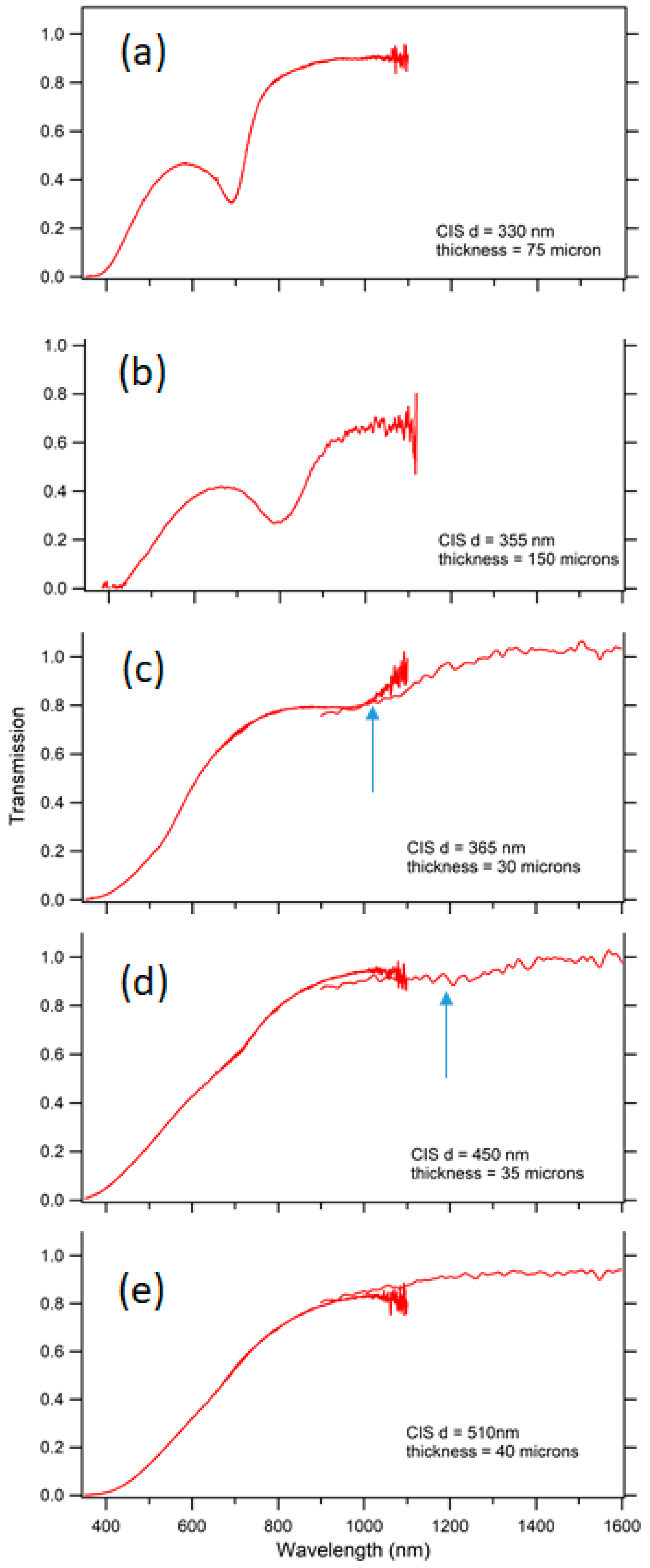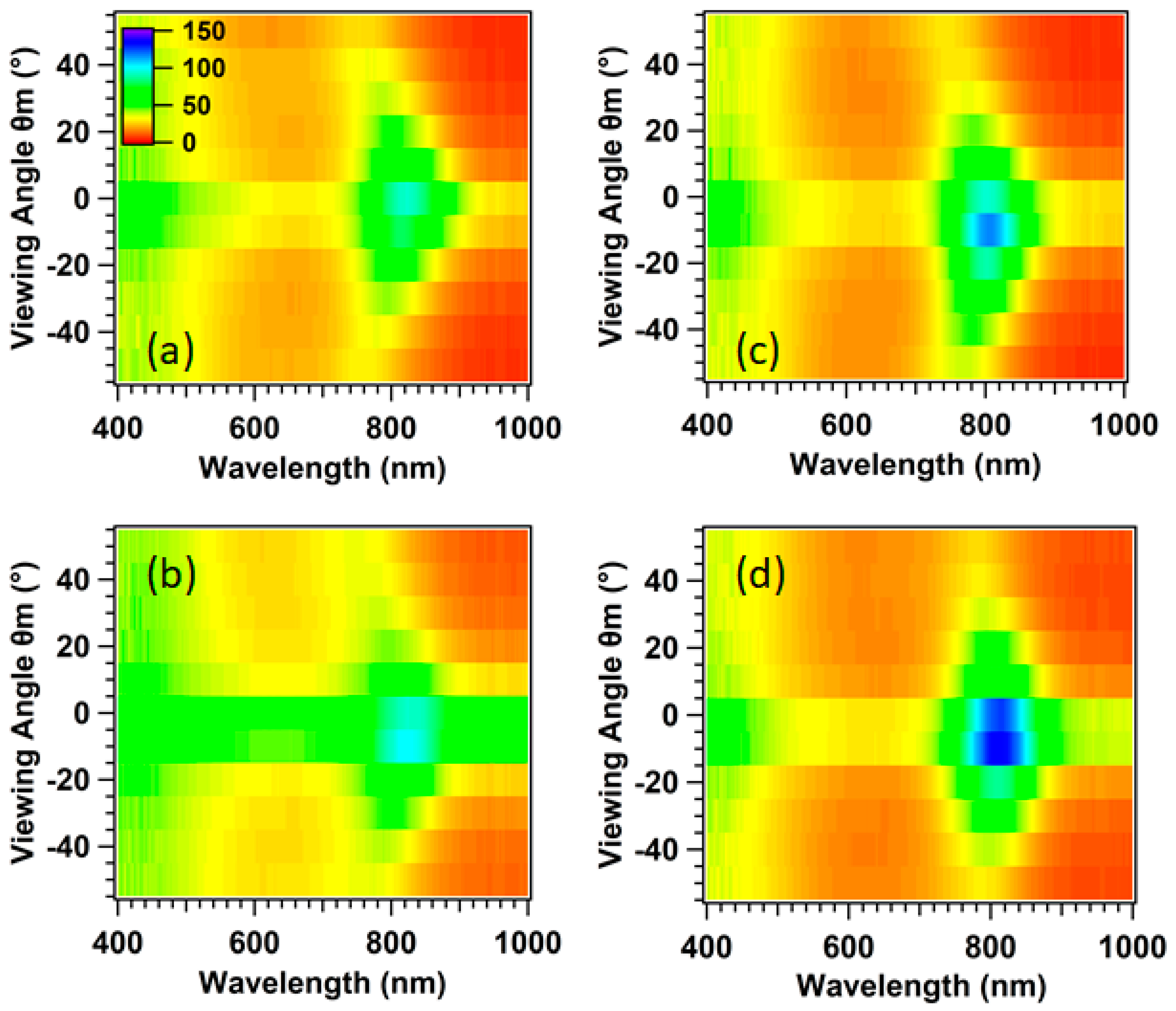Extending Polymer Opal Structural Color Properties into the Near-Infrared
Abstract
1. Introduction
2. Materials and Methods
2.1. Opal Synthesis and Thin-Film Fabrication
2.1.1. Reagents
2.1.2. Procedure
2.2. Structural Characterisation
2.3. Optical Spectroscopy
2.3.1. Thin-Film Transmittance
2.3.2. Goniometric Reflectometry
3. Results
3.1. Structures
3.2. Optical Characterisation
3.2.1. Visible/NIR Spectroscopy
3.2.2. Scattering Cones
4. Discussion and Conclusions
Author Contributions
Funding
Institutional Review Board Statement
Informed Consent Statement
Data Availability Statement
Acknowledgments
Conflicts of Interest
Appendix A


References
- Pursiainen, O.L.J.; Baumberg, J.J.; Winkler, H.; Viel, B.; Spahn, P.; Ruhl, T. Shear-Induced Organization in Flexible Polymer Opals. Adv. Mater. 2008, 20, 1484–1487. [Google Scholar] [CrossRef]
- Finlayson, C.E.; Baumberg, J.J. Polymer opals as novel photonic materials. Polym. Int. 2013, 62, 1403–1407. [Google Scholar] [CrossRef]
- Gallei, M. Functional Polymer Opals and Porous Materials by Shear-Induced Assembly of Tailor-Made Particles. Macromol. Rapid Commun. 2018, 39, 16. [Google Scholar] [CrossRef]
- Ruhl, T.; Hellmann, G.P. Colloidal Crystals in Latex Films: Rubbery Opals. Macromol. Chem. Phys. 2001, 202, 3502–3505. [Google Scholar] [CrossRef]
- Ding, T.; Cao, G.; Schäfer, C.G.; Zhao, Q.; Gallei, M.; Smoukov, S.K.; Baumberg, J.J. Revealing Invisible Photonic Inscriptions: Images from Strain. ACS Appl. Mater. Interfaces 2015, 7, 13497–13502. [Google Scholar] [CrossRef] [PubMed]
- Braun, P. MATERIALS SCIENCE Colour without colourants. Nature 2011, 472, 423–424. [Google Scholar] [CrossRef]
- Zhao, Q.; Finlayson, C.E.; Snoswell, D.R.E.; Haines, A.; Schäfer, C.; Spahn, P.; Hellmann, G.P.; Petukhov, A.V.; Herrmann, L.; Burdet, P.; et al. Large-scale ordering of nanoparticles using viscoelastic shear processing. Nat. Commun. 2016, 7, 11661. [Google Scholar] [CrossRef]
- Finlayson, C.E.; Rosetta, G.; Baumberg, J.J. An Experimental and Theoretical Determination of Oscillatory Shear-Induced Crystallization Processes in Viscoelastic Photonic Crystal Media. Materials 2021, 14, 5298. [Google Scholar] [CrossRef] [PubMed]
- Haines, A.I.; Finlayson, C.E.; Snoswell, D.R.E.; Spahn, P.; Hellmann, G.P.; Baumberg, J.J. Anisotropic Resonant Scattering from Polymer Photonic Crystals. Adv. Mater. 2012, 24, OP305–OP308. [Google Scholar] [CrossRef]
- Schäfer, C.G.; Gallei, M.; Zahn, J.T.; Engelhardt, J.; Hellmann, G.P.; Rehahn, M. Reversible Light-, Thermo-, and Mechano-Responsive Elastomeric Polymer Opal Films. Chem. Mater. 2013, 25, 2309–2318. [Google Scholar] [CrossRef]
- Snoswell, D.R.E.; Kontogeorgos, A.; Baumberg, J.J.; Lord, T.D.; Mackley, M.R.; Spahn, P.; Hellmann, G.P. Shear ordering in polymer photonic crystals. Phys. Rev. E 2010, 81, 020401. [Google Scholar] [CrossRef] [PubMed]
- Lange, B.; Metz, N.; Tahir, M.N.; Fleischhaker, F.; Theato, P.; Schröder, H.; Müller, W.E.G.; Tremel, W.; Zentel, R. Functional Polymer-Opals from Core–Shell Colloids. Macromol. Rapid Commun. 2007, 28, 1987–1994. [Google Scholar] [CrossRef]
- Joannopoulos, J.D.; Johnson, S.G.; Winn, J.N.; Meade, R.D. Photonic Crystals Molding the Flow of Light, 2nd ed.; Princeton University Press: Princeton, NJ, USA, 2008. [Google Scholar]
- Rosetta, G. Towards the Realisation of Polymer Opals as Next Generation Functional Materials. Ph.D. Thesis, Aberystwyth University, Aberystwyth, UK, 2023. [Google Scholar]
- Rosetta, G.; Macaire, L.; Butters, M.; Finlayson, C.E. Dial-In Synthesis of ‘Polymer Opal’ Core–Interlayer–Shell Composite Nanoparticles. Polymers 2023, 15, 3507. [Google Scholar] [CrossRef] [PubMed]
- Li, W.; Shi, Y.; Chen, K.; Zhu, L.; Fan, S. A Comprehensive Photonic Approach for Solar Cell Cooling. ACS Photonics 2017, 4, 774–782. [Google Scholar] [CrossRef]
- Bermel, P.; Luo, C.; Zeng, L.; Kimerling, L.C.; Joannopoulos, J.D. Improving thin-film crystalline silicon solar cell efficiencies with photonic crystals. Opt. Express 2007, 15, 16986–17000. [Google Scholar] [CrossRef] [PubMed]
- Bhattacharya, J.; Chakravarty, N.; Pattnaik, S.; Slafer, W.D.; Biswas, R.; Dalal, V.L. A photonic-plasmonic structure for enhancing light absorption in thin film solar cells. Appl. Phys. Lett. 2011, 99, 3. [Google Scholar] [CrossRef]
- Wehrspohn, R.B.; Üpping, J. 3D photonic crystals for photon management in solar cells. J. Opt. 2012, 14, 9. [Google Scholar] [CrossRef]
- Üpping, J.; Biclawny, A.; Miclea, P.T.; Wehrspohn, R.B. 3D photonic crystals for ultra-light trapping in solar cells. In Proceedings of the Conference on Photonics for Solar Energy Systems II, Strasbourg, France, 7–8 April 2008. [Google Scholar]
- Liu, W.; Ma, H.; Walsh, A. Advance in photonic crystal solar cells. Renew. Sustain. Energy Rev. 2019, 116, 109436. [Google Scholar] [CrossRef]
- Broderick, K.A.; Zeng, L.; Alamariu, B.A.; Duan, X.; Zou, Z.; Zhou, J.; Sun, X.; Yi, Y. Enhanced Absorption in Thin Film Si Solar Cells with Textured Photonic Back Reflector. In Proceedings of the Conference on Lasers and Electro-Optics (CLEO)/Quantum Electronics and Laser Science Conference (QELS), IEEE, San Jose, CA, USA, 16–21 May 2010. [Google Scholar]
- Wang, J.L.; Xuan, Y.M.; Da, Y.; Xu, Y.P.; Zheng, L.K. Benefits of photonic management strategy for highly efficient bifacial solar cells. Opt. Commun. 2020, 462, 125358. [Google Scholar] [CrossRef]
- Nicholson, J. The Chemistry of Polymers; Royal Society of Chemistry: London, UK, 2017. [Google Scholar]
- Ottewill, R.H.; Shaw, J.N. Studies on the preparation and characterization of monodisperse polystyrene latices. Kolloid-Z. Z. Polym. 1967, 215, 161–166. [Google Scholar] [CrossRef]
- Chern, C.S. Principles and Applications of Emulsion Polymerization; Wiley: New York, NY, USA, 2008. [Google Scholar]
- Ruhl, T.; Spahn, P.; Hellmann, G. Artificial opals prepared by melt compression. Polymer 2003, 44, 7625–7634. [Google Scholar] [CrossRef]
- Li, H.T.; Wu, P.; Zhao, G.W.; Guo, J.; Wang, C.C. Fabrication of industrial-level polymer photonic crystal films at ambient temperature Based on uniform core/shell colloidal particles. J. Colloid Interface Sci. 2021, 584, 145–153. [Google Scholar] [CrossRef] [PubMed]
- Ruhl, T.; Spahn, P.; Winkler, H.; Hellmann, G.P. Large Area Monodomain Order in Colloidal Crystals. Macromol. Chem. Phys. 2004, 205, 1385–1393. [Google Scholar] [CrossRef]
- Chern, C.-S.; Lin, S.-Y.; Hsu, T.J. Effects of Temperature on Styrene Emulsion Polymerization Kinetics. Polym. J. 1999, 31, 516–523. [Google Scholar] [CrossRef]
- Zhao, Q.; Finlayson, C.E.; Schaefer, C.G.; Spahn, P.; Gallei, M.; Herrmann, L.; Petukhov, A.V.; Baumberg, J.J. Nanoassembly of Polydisperse Photonic Crystals Based on Binary and Ternary Polymer Opal Alloys. Adv. Opt. Mater. 2016, 4, 1494–1500. [Google Scholar] [CrossRef]
- Spahn, P.; Finlayson, C.E.; Etah, W.M.; Snoswell, D.R.E.; Baumberg, J.J.; Hellmann, G.P. Modification of the refractive-index contrast in polymer opal films. J. Mater. Chem. 2011, 21, 8893–8897. [Google Scholar] [CrossRef]
- Finlayson, C.E.; Spahn, P.; Snoswell, D.R.E.; Yates, G.; Kontogeorgos, A.; Haines, A.I.; Hellmann, G.P.; Baumberg, J.J. 3D Bulk Ordering in Macroscopic Solid Opaline Films by Edge-Induced Rotational Shearing. Adv. Mater. 2011, 23, 1540–1544. [Google Scholar] [CrossRef] [PubMed]
- Rosetta, G.; An, T.; Zhao, Q.B.; Baumberg, J.J.; Tomes, J.J.; Gunn, M.D.; Finlayson, C.E. Chromaticity of structural color in polymer thin film photonic crystals. Opt. Express 2020, 28, 36219–36228. [Google Scholar] [CrossRef]
- Snoswell, D.R.E.; Finlayson, C.E.; Zhao, Q.; Baumberg, J.J. Real-time measurements of crystallization processes in viscoelastic polymeric photonic crystals. Phys. Rev. E 2015, 92, 052315. [Google Scholar] [CrossRef]
- Finlayson, C.E.; Baumberg, J.J. Generating Bulk-Scale Ordered Optical Materials Using Shear-Assembly in Viscoelastic Media. Materials 2017, 10, 688. [Google Scholar] [CrossRef]
- Rosetta, G.; Gunn, M.; Tomes, J.J.; Butters, M.; Pieschel, J.; Hartmann, F.; Gallei, M.; Finlayson, C.E. Transparent Polymer Opal Thin Films with Intense UV Structural Color. Molecules 2022, 27, 3774. [Google Scholar] [CrossRef]
- Baumberg, J.J.; Pursiainen, O.L.; Spahn, P. Resonant optical scattering in nanoparticle-doped polymer photonic crystals. Phys. Rev. B 2009, 80, 201103. [Google Scholar] [CrossRef]
- Wang, Z.Z.; Zhang, C.F.; Chen, D.Z.; Tang, S.; Zhang, J.C.; Wang, Y.; Han, G.Q.; Xu, S.R.; Hao, Y. Flexible ITO-Free Organic Solar Cells Based on MoO3Ag Anodes. IEEE Photonics J. 2015, 7, 9. [Google Scholar] [CrossRef]
- Pattnaik, S.; Biswas, R.; Dalal, V.L.; Slafer, D.; Ji, J. Amorphous Silicon Solar Cells on Plastic Based Photonic Structures. In Proceedings of the 35th IEEE Photovoltaic Specialists Conference, IEEE, Honolulu, HI, USA, 20–25 June 2010; pp. 1483–1486. [Google Scholar]
- Krebs, F.C.; Jørgensen, M.; Norrman, K.; Hagemann, O.; Alstrup, J.; Nielsen, T.D.; Fyenbo, J.; Larsen, K.; Kristensen, J. A complete process for production of flexible large area polymer solar cells entirely using screen printing—First public demonstration. Sol. Energy Mater. Sol. Cells 2009, 93, 422–441. [Google Scholar] [CrossRef]
- Parchine, M.; Kohoutek, T.; Bardosova, M.; Pemble, M.E. Large area colloidal photonic crystals for light trapping in flexible organic photovoltaic modules applied using a roll-to-roll Langmuir-Blodgett method. Sol. Energy Mater. Sol. Cells 2018, 185, 158–165. [Google Scholar] [CrossRef]
- Tang, X.S.; Ma, Z.G.; Wang, W.Q.; Deng, Z.; Jiang, Y.; Wang, W.X.; Chen, H.; Zhang, N.; Huang, K.Y.; Du, C.H.; et al. Improving the Performance of Solar Cells under Non-Perpendicular Incidence by Photonic Crystal. IEEE Photon-J. 2021, 13, 8400204. [Google Scholar] [CrossRef]
- Tayagaki, T.; Kishimoto, Y.; Hoshi, Y.; Usami, N. Light trapping by direction-dependent light transmission in front-surface photonic nanostructures. Appl. Phys. Express 2014, 7, 122301. [Google Scholar] [CrossRef]
- Snoswell, D.R.E.; Baumberg, J.J. Stretching the Imagination. Textiles 2009, 4, 8–10. [Google Scholar]
- Schäfer, C.G.; Biesalski, M.; Hellmann, G.P.; Rehahn, M.; Gallei, M. Paper-supported elastomeric opal films for enhanced and reversible solvatochromic response. J. Nanophotonics 2013, 7, 070599. [Google Scholar] [CrossRef]
- Jhumka, H.; Yang, S.; Gorse, C.; Wilkinson, S.; Yang, R.; He, B.-J.; Prasad, D.; Fiorito, F. Assessing heat transfer characteristics of building envelope deployed BIPV and resultant building energy consumption in a tropical climate. Energy Build. 2023, 298, 24. [Google Scholar] [CrossRef]
- Martín-Chivelet, N.; Kapsis, K.; Wilson, H.R.; Delisle, V.; Yang, R.B.C.; Olivieri, L.; Polo, J.; Eisenlohr, J.; Roy, B.; Maturi, L.; et al. Building-Integrated Photovoltaic (BIPV) products and systems: A review of energy-related behavior. Energy Build. 2022, 262, 111998. [Google Scholar] [CrossRef]





| Sample No. | CIS Diameter (nm) | (nm) 1 | Thickness (μm) | T (%) | α (mm−1) 2 |
|---|---|---|---|---|---|
| 1 | 330 | 690 | 75 | 0.34 | 14.4 |
| 2 | 355 | 790 | 80 | 0.35 | 13.1 |
| 3 | 365 | 970 | 30 | 0.79 | 7.86 |
| 4 | 450 | ≈1200 | 35 | 0.88 | 3.20 |
| 5 | 510 | >1600 | 40 | - | - |
| No. of BIOS Cycles | 0 | 5 | 10 | 20 | 40 |
|---|---|---|---|---|---|
| FWHM (°) | - | 20 ± 4 | 17 ± 3 | 23 ± 2 | 20 ± 1 |
| Peak Reflectance (%) | - | 54 ± 8 | 61 ± 8 | 75 ± 5 | 100 ± 6 |
| Peak λ (nm) 1 | ≈831 | 823 | 820 | 805 | 806 |
Disclaimer/Publisher’s Note: The statements, opinions and data contained in all publications are solely those of the individual author(s) and contributor(s) and not of MDPI and/or the editor(s). MDPI and/or the editor(s) disclaim responsibility for any injury to people or property resulting from any ideas, methods, instructions or products referred to in the content. |
© 2024 by the authors. Licensee MDPI, Basel, Switzerland. This article is an open access article distributed under the terms and conditions of the Creative Commons Attribution (CC BY) license (https://creativecommons.org/licenses/by/4.0/).
Share and Cite
Rosetta, G.; Gunn, M.; Tomes, J.J.; Butters, M.; Finlayson, C.E. Extending Polymer Opal Structural Color Properties into the Near-Infrared. Micro 2024, 4, 387-400. https://doi.org/10.3390/micro4020024
Rosetta G, Gunn M, Tomes JJ, Butters M, Finlayson CE. Extending Polymer Opal Structural Color Properties into the Near-Infrared. Micro. 2024; 4(2):387-400. https://doi.org/10.3390/micro4020024
Chicago/Turabian StyleRosetta, Giselle, Matthew Gunn, John J. Tomes, Mike Butters, and Chris E. Finlayson. 2024. "Extending Polymer Opal Structural Color Properties into the Near-Infrared" Micro 4, no. 2: 387-400. https://doi.org/10.3390/micro4020024
APA StyleRosetta, G., Gunn, M., Tomes, J. J., Butters, M., & Finlayson, C. E. (2024). Extending Polymer Opal Structural Color Properties into the Near-Infrared. Micro, 4(2), 387-400. https://doi.org/10.3390/micro4020024








